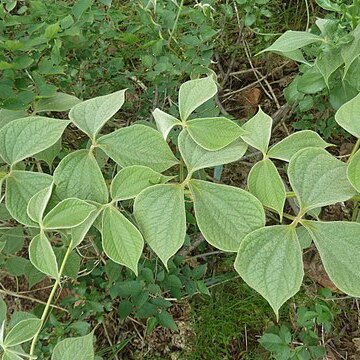Vine, ± 12 m high; stems left-twining, armed; tubers solitary, lobed or in a dense cluster; hairs sparse to velutinous. Leaves petiolate, terminal leaflet 180 x 150 mm, (broadly) obovate, base rounded, apex cuspidate, margins entire. Male inflorescences compound, ± 300 mm long; flowers in 2-or 3-flowered cymules. Male flowers: filaments at base of inner tepals; anthers 0.6 x 0.5 mm. Female inflorescences spicate, ± 140 mm long. Female flowers subpendent; tepals membranous, pubescent, each with basal staminode; ovary ± 6 mm long. Flowering time Oct.-Feb. Fruit a capsule, 50 x 27 mm. Seeds: wing oblong.
A yam. It is a climbing herb. The stems are angular and downy. It has bulbs. The tuber is large and 30 cm across. There can be a cluster of tubers. The leaves are alternate with 3 leaflets. They are round and hairy underneath. Male and female flowers are on separate plants. Male flowers are green and female flowers are white. They are in small hanging clusters in the axils or leaves. The stems are spiny. It can grow 15 m high. The fruit are winged and 4 cm long.
Climber. Plant hairy. Leaves 3-foliolate, covered with silvery, velvet hairs, broadly ovate, apex attenuate, up to 150 x 110 mm. Fruit up to 50 x 25 mm. Flowers green.


